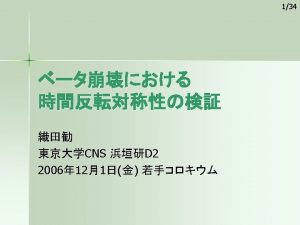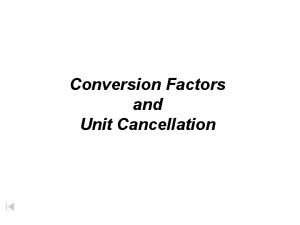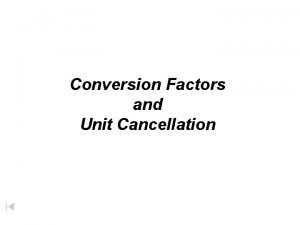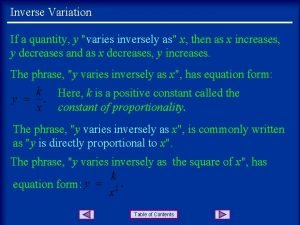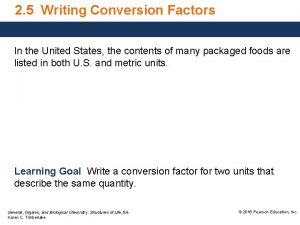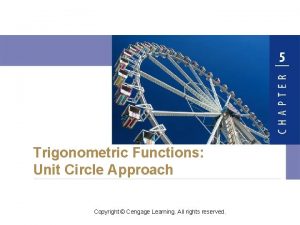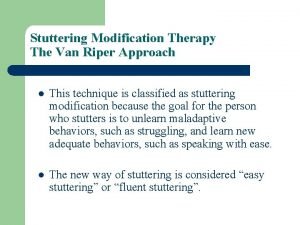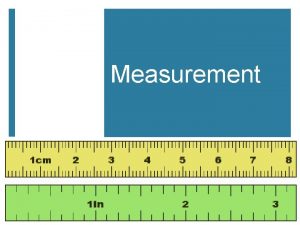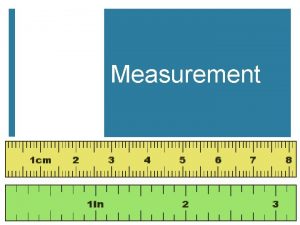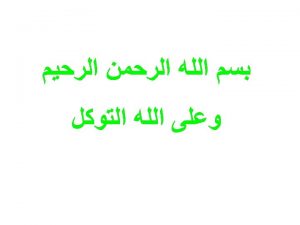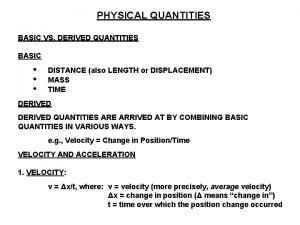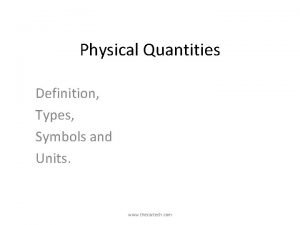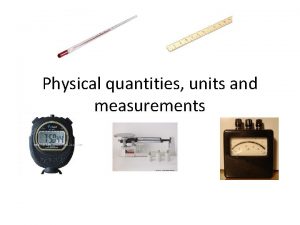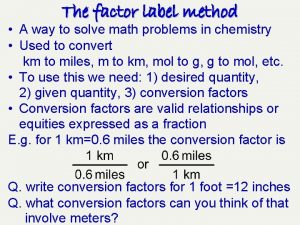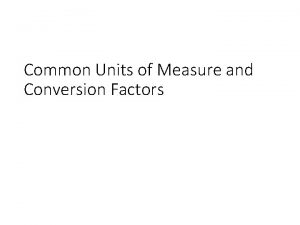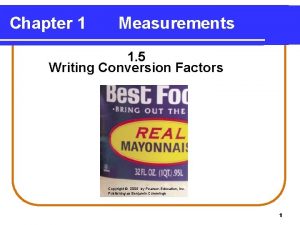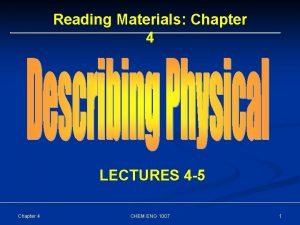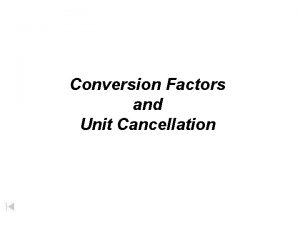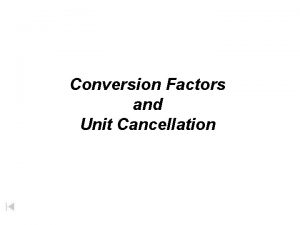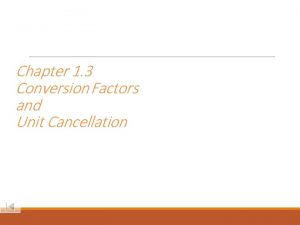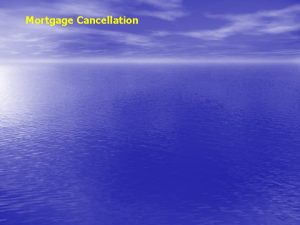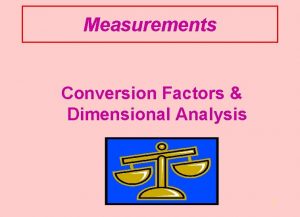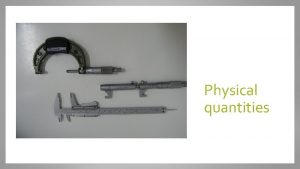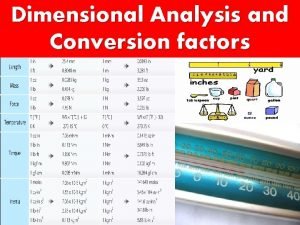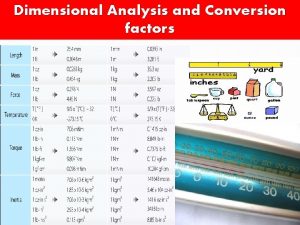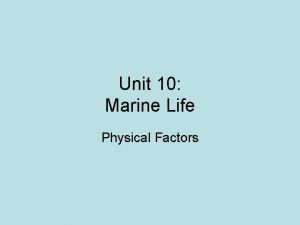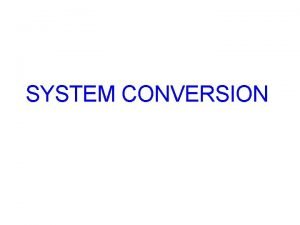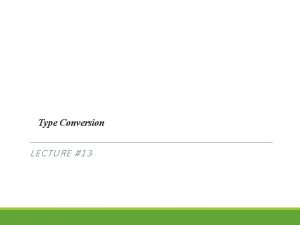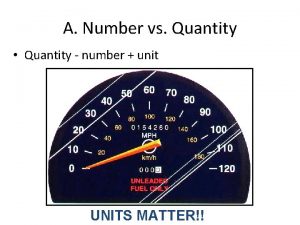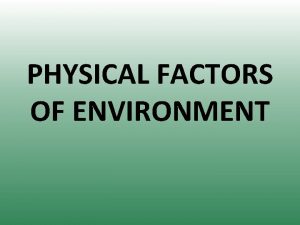Conversion Factors and Unit Cancellation A physical quantity
































- Slides: 32

Conversion Factors and Unit Cancellation

A physical quantity must include: Number + Unit


Some Prefixes • • Kilo - 1000 k Hecto - 100 h Deca - 10 da 1 Deci - 0. 1 d Centi - 0. 01 c Milli - 0. 001 m

Length • The basic unit of length in the metric system is the meter (m) • Metric Units of Length – – – – Kilometer (km) = 1000 m Hectometer (hm) = 100 m Decameter (dam) = 10 m Meter (m) = 1 m Decimeter (dm) = 0. 1 m Centimeter (cm) = 0. 01 m Millimeter (mm) = 0. 001 m

Mass • The basic unit of mass in the metric system is a gram (g) • 1 g = mass of water in a cube that measures 1 cm x 1 cm • Metric Units of Mass – – – – Kilogram (kg) = 1000 g Hectogram (hg) = 100 g Decagram (dag) = 10 g Gram (g) = 1 g Decigram (dg) = 0. 1 g Centigram (cg) = 0. 01 g Milligram (mg) = 0. 001 g

Capacity • Liquid substances are measured in units of capacity. • The basic unit of mass in the metric system is a liter (L) • 1 L = capacity of a cube that measures 10 cm x 10 cm • Metric Units of Capacity – – – – Kiloliter (k. L) = 1000 L Hectoliter (h. L) = 100 L Decaliter (da. L) = 10 L Liter (L) = 1 L Deciliter (d. L) = 0. 1 L Centiliter (c. L) = 0. 01 L Milliliter (m. L) = 0. 001 L

Volume • The most commonly used metric units for volume are the liter (L) and the milliliter (m. L). – A liter is a cube 1 decimeter (dm) long on each side. – A milliliter is a cube 1 centimeter (cm) long on each side. © 2012 Pearson Education, Inc.

Ladder Method 1 2 KILO 1000 Units HECTO 100 Units 3 DEKA 10 Units Meters Liters Grams DECI 0. 1 Unit How do you use the “ladder” method? 1 st – Determine your starting point. 2 nd – Count the “jumps” to your ending point. 3 rd – Move the decimal the same number of jumps in the same direction. CENTI 0. 01 Unit MILLI 0. 001 Unit 4 km = _____ m Starting Point Ending Point How many jumps does it take? 4. __. __. = 4000 m 1 2 3

Conversion Practice Try these conversions using the ladder method. 1000 mg = _______ g 1 L = _______ m. L 160 cm = _______ mm 14 km = _______ m 109 g = _______ kg 250 m = _______ km Compare using <, >, or =. 56 cm 6 m 7 g 698 mg

Metric Conversion Challenge Write the correct abbreviation for each metric unit. 1) Kilogram _____ 4) Milliliter _____ 7) Kilometer _____ 2) Meter _____ 5) Millimeter _____ 8) Centimeter _____ 3) Gram _____ 6) Liter _____ 9) Milligram _____ Try these conversions, using the ladder method. 10) 2000 mg = _______ g 15) 5 L = _______ m. L 20) 16 cm = _______ mm 11) 104 km = _______ m 16) 198 g = _______ kg 21) 2500 m = _______ km 12) 480 cm = _____ m 17) 75 m. L = _____ L 22) 65 g = _____ mg 13) 5. 6 kg = _____ g 18) 50 cm = _____ m 23) 6. 3 cm = _____ mm 14) 8 mm = _____ cm 19) 5. 6 m = _____ cm 24) 120 mg = _____ g

Compare using <, >, or =. 25) 63 cm 26) 536 cm 6 m 53. 6 dm 27) 5 g 28) 43 mg 508 mg 5 g 29) 1, 500 m. L 30) 3. 6 m 1. 5 L 36 cm

Temperature © 2012 Pearson Education, Inc.

Temperature • • The kelvin is the SI unit of temperature. It is based on the properties of gases. There are no negative Kelvin temperatures. K = C + 273. 15

Temperature • The Fahrenheit scale is not used in scientific measurements. • F = 1. 8( C) + 32

Calculation Corner: Unit Conversion 1 Cal = 4. 184 J

Calculation Corner: Unit Conversion 1 Cal 4. 184 J 1 Cal “Conversion factors”

Calculation Corner: Unit Conversion 1 Cal 4. 184 J 1 Cal “Conversion factors” ( 5 Cal )( 4. 184 J 1 Cal ) = 20. 92 J

How many cm are in 1. 32 meters? equality: 1 m = 100 cm (or 0. 01 m = 1 cm) applicable conversion factors: ______ 1 m 100 cm or ( 100 cm ______ 1 m ) cm 100 ______ X cm = 1. 32 m = 132 cm 1 m We use the idea of unit cancellation to decide upon which one of the two conversion factors we choose.

How many meters is 8. 72 cm? equality: 1 m = 100 cm applicable conversion factors: ______ 1 m 100 cm or ( 100 cm ______ 1 m ) 1 m ______ X m = 8. 72 cm = 0. 0872 m 100 cm Again, the units must cancel.

How many kilometers is 15, 000 decimeters? ( )( 1 m X km = 15, 000 dm ____ 10 dm ) 1 km ______ = 1. 5 km 1, 000 m

How many seconds is 4. 38 days? ( )( 24 h X s = 4. 38 d ____ 1 d )( ) 60 min _____ 1 h 60 s ____ 1 min = 378, 432 s If we are accounting for significant figures, we would change this to… 3. 78 x 105 s

Simple Math with Conversion Factors

Example Problem Measured dimensions of a rectangle: length (L) = 9. 70 cm width (W) = 4. 25 cm Find area of rectangle. L A = L. W = (9. 70 cm)(4. 25 cm) = 41. 2 2 cm. cm W

Convert 41. 2 cm 2 to m 2. ) ( 1 m X m 2 = 41. 2 cm 2 ______ = 0. 412 m 2 WRONG! 100 cm = 0. 412 cm. m Recall that… 41. 2 cm 2 = 41. 2 cm. cm X m 2 = 41. 2 cm. cm ( )( ) 1 m ______ 100 cm = 0. 00412 m 2 X m 2 = 41. 2 cm 2 ( ) 1 m ______ 100 cm 2 = 0. 00412 m 2

Convert 41. 2 cm 2 to mm 2. Recall that… 41. 2 cm 2 = 41. 2 cm. cm ( X mm 2 = 41. 2 cm. cm _____ 10 mm 1 cm )( 1 cm = 4, 120 mm 2 10 mm _____ ) = 4, 120 mm 2 ( 10 mm X mm 2 = 41. 2 cm 2 _____ 1 cm ) 2

Measured dimensions of a rectangular solid: Length = 15. 2 cm Width = 3. 7 cm Height = 8. 6 cm H Find volume of solid. L V = L. W. H = (15. 2 cm)(3. 7 cm)(8. 6 cm) 3 = 480 cm W

Convert to m 3. cm. cm ( )( 2 3 1 m X m 3 = 480 cm _____ 100 cm 1 m _____ )( 100 cm ) 1 m _____ = 100 cm or ( ) 1 m X m 3 = 480 cm 3 _____ 100 cm or X m 3 = 480 cm 3 ( 3 3 = 0. 000480 m 3 ) 1 m _____ 4. 80 x 10 -4 m 3 = 1000000 cm 3

Convert to m 3. . . Measured dimensions of a rectangular solid: Length = 15. 2 cm 0. 152 m Width = 3. 7 cm 0. 037 m Height = 8. 6 cm 0. 086 m H Find volume of solid. L V = L. W. H = (0. 152 m)(0. 037 m)(0. 086 m) = 0. 000480 m 3 W

By what factor do mm and cm differ? 1 cm = 10 mm 10 By what factor do mm 2 and cm 2 differ? 1 cm 22 = 100 mm (1 cm) = (10 mm)2 2 100 By what factor do mm 3 and cm 3 differ? 1 cm 33 = 1000 mm (1 cm) = (10 mm)33 1, 000


 Vector quantity?
Vector quantity? Scalar quantity and vector quantity
Scalar quantity and vector quantity Scalar quantities have size or magnitude only
Scalar quantities have size or magnitude only Scalar vector tensor
Scalar vector tensor Cancellation of units
Cancellation of units Unit cancellation
Unit cancellation 5 physical quantities
5 physical quantities Quantity y varies inversely as quantity x
Quantity y varies inversely as quantity x Writing conversion factors
Writing conversion factors Cancellation property trig
Cancellation property trig Mundrawms adani security app
Mundrawms adani security app Srinivas kotni
Srinivas kotni Van riper approach
Van riper approach Defence travel system e ticketing
Defence travel system e ticketing Clutter cancellation
Clutter cancellation Absa home loans
Absa home loans Flight cancellation predictor
Flight cancellation predictor Keralartconline. com
Keralartconline. com Digital audio and speech
Digital audio and speech Pgl cancellation policy
Pgl cancellation policy Explorica tours
Explorica tours A quantity that has both a number and a unit
A quantity that has both a number and a unit A quantity that has both a number and a unit
A quantity that has both a number and a unit Quantity name
Quantity name Derived quantities
Derived quantities International system
International system Physical quantity of microammeter
Physical quantity of microammeter How to factor label
How to factor label Grid ratio formula
Grid ratio formula Mlbs to lbs
Mlbs to lbs Write conversion factors for each equality
Write conversion factors for each equality Write conversion factors for each equality
Write conversion factors for each equality Convert 23 lbm.ft/min2 to its equivalent in kg.cm/s2
Convert 23 lbm.ft/min2 to its equivalent in kg.cm/s2



